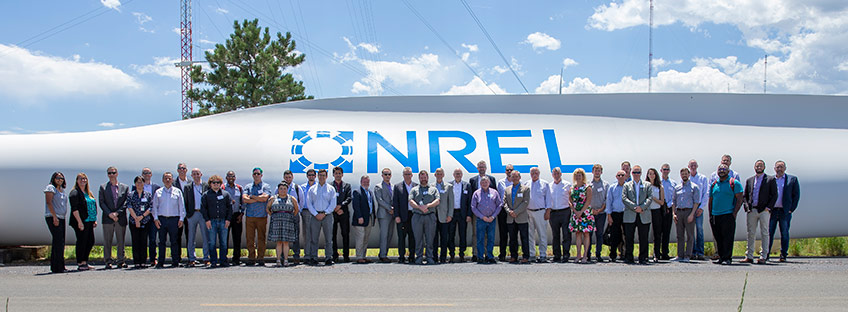The Leading Edge: August 2019 Wind Energy Newsletter
Read this issue to learn about NREL researchers improving energy output through operational analyses and development of taller turbines, assessing cybersecurity threats to U.S. wind power plants, and a discussion of the wind energy workforce gap.

Representatives from the national lab complex, wind industry, manufacturers, cybersecurity product vendors, and standards organizations came together at NREL's Flatirons Campus for a workshop evaluating cybersecurity vulnerabilities on U.S. wind farms.
News Stories
Addressing the Wind Energy Workforce Gap
An NREL report titled, "The Wind Energy Workforce in the United States: Training, Hiring, and Future Needs," indicates that the wind industry is having difficulty finding qualified applicants for entry-level positions, whereas students graduating from wind-related programs are not finding jobs in their field. This disparity is known as the wind energy workforce gap.
Addressing this gap could reduce recruiting costs, meet employer needs, and help grow the domestic wind workforce.
Read more about the report.
New Open-Source Software Tool Could Improve Operational Wind Industry Analyses
NREL has released Open Operational Assessment (OpenOA), a new open-source software tool that provides a generalized framework for working with wind power plant operational data. The software tool aims to foster collaboration among wind industry professionals who contribute to more efficient deployment of resources and knowledge sharing.
Tall Towers Tap Greater Wind Resource Potential
As wind technology grows in scale and productivity, researchers continue to look for ways to boost the energy captured while driving down costs.
In "Increasing Wind Turbine Tower Heights: Opportunities and Challenges," NREL researchers examine opportunities for increasing the height of wind turbine hubs—where the turbine drivetrain and rotors attach—and the conditions and locations where taller towers would have the most impact.
Workshop Convenes Experts to Evaluate the Cybersecurity of U.S. Wind Farms
Earlier this month, NREL hosted a workshop to evaluate the growing potential for cybersecurity vulnerabilities within U.S. wind farms. The workshop, "Assessing the Impact of Cybersecurity on the Nation's Wind Farms," brought together researchers across the national lab complex, the wind energy industry, original equipment manufacturers, cybersecurity product vendors, and standards organizations.
Learn more about the workshop and NREL's work in cybersecurity.
Recent Wind Publications
Assessing Wind Power Operating Costs in the United States: Results From a Survey of Wind Industry Experts
A journal article by researchers from Lawrence Berkeley National Laboratory and NREL researcher Eric Lantz in Renewable Energy Focus draws on a survey of wind industry professionals to clarify trends in the operational expenditures of U.S. land-based wind power plants. The study finds that operational expenditure costs have declined from approximately $80/kilowatt/year for projects built in the late 1990s to about $40/kilowatt/year for projects built in 2018. Survey findings indicate that learning rates show a 9% reduction of operational expenditures for each doubling of global wind capacity, suggesting that continued operational expenditure reductions may contribute 10% or more of the expected reductions in land-based wind's levelized cost of energy.
For a quick review of the report, you can read more from AWEA's Into the Wind blog post summary.
NREL Provides Detailed Wind Turbine Blade Cost Model to Industry
NREL researchers published "A Detailed Wind Turbine Blade Cost Model" which details a cost model for wind turbine blades between 30 and 100 meters in length. The model considers estimates of the bill of materials, the number of labor hours and the cycle time, and the costs related to direct labor, overhead, buildings, tooling, equipment, maintenance, and capital. The model is implemented both in a large Microsoft Excel file and in Python. The latter is freely available in the repository of the Wind-Plant Integrated System Design and Engineering Model (WISDEM®), a multidisciplinary analysis and optimization design framework developed at NREL.
Report Investigates Drivers for White-Etching Crack Failure Modes in Wind Turbine Gearbox High-Speed-Shaft Bearings
Wind power plant operation and maintenance costs account for as much as 20% to 50% of the wind power purchase agreement price and generally increase as wind power plants age. Failures in gearbox bearings have been a primary source of reliability issues for wind turbine drivetrains, leading to costly downtime and unplanned maintenance. The most common failure mode of gearboxes is attributed to white-etching cracks, examined in the NREL report, "Investigation of Roller Sliding in Wind Turbine Gearbox High-Speed-Shaft Bearings."
Researchers Validate Findings of Previous Model-Based Assessment of Alaska's Offshore Wind Resource Potential
A journal article from NREL and the National Center for Atmospheric Research titled, "Wind Resource Assessment for Alaska's Offshore Regions: Validation of a 14-Year High-Resolution WRF Data Set," helps validate a 14-year wind resource assessment of Alaska's offshore energy potential that was published in the NREL technical report, "Offshore Wind Energy Resource Assessment for Alaska." Researchers validated the regional climate simulations in the technical report with available radiosonde and surface wind observations to confirm the model-based assessment. Although additional offshore measurements are needed to accompany the land-based measurements, simulation data from the technical report indicate that a small area near Alaska's population centers and the largest transmission grid, if even partially developed, could provide the bulk of the state's energy needs.
Turbulent Kinetic Energy Found as A Significant Variable for Machine-Learning Models
The influence of atmospheric turbulence and stability measurements is often overlooked when building the best machine-learning model to improve wind power forecasting. NREL research examines the impact of atmospheric turbulence and stability inputs on machine-learning model predictions of wind farm power output and finds that considerable improvement in hourly power predictions results from the inclusion of turbulence or stability measures—especially turbulent kinetic energy—in forecasting models.
Read more about this research in Renewable and Sustainable Energy Reviews.
Share

